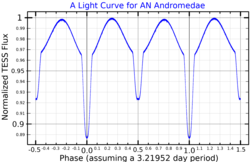| Observation data Epoch J2000 Equinox J2000 | |
|---|---|
| Constellation | Andromeda |
| Right ascension | 23h 18m 23.32202s[2] |
| Declination | +41° 46′ 25.2031″[2] |
| Apparent magnitude (V) | 5.98[3] |
| Characteristics | |
| Spectral type | A7 V[4] or A7m[3] |
| B−V color index | 0.215±0.002[3] |
| Variable type | β Lyr[5] |
| Astrometry | |
| Radial velocity (Rv) | −3.8±2.9[3] km/s |
| Proper motion (μ) | RA: −10.266[2] mas/yr Dec.: −9.791[2] mas/yr |
| Parallax (π) | 7.0976 ± 0.0544 mas[2] |
| Distance | 460 ± 4 ly (141 ± 1 pc) |
| Absolute magnitude (MV) | 0.43[3] |
| Orbit[6] | |
| Period (P) | 3.2196 d |
| Eccentricity (e) | 0.03 |
| Inclination (i) | 60.2[7]° |
| Periastron epoch (T) | 2,436,094.876 JD |
| Semi-amplitude (K1) (primary) | 71.6 km/s |
| Details[7] | |
| 9 And A | |
| Mass | 2.48 M☉ |
| Radius | 3.51 R☉ |
| Luminosity | 49.2 L☉ |
| Temperature | 8,200 K |
| Rotational velocity (v sin i) | 81[8] km/s |
| 9 And B | |
| Mass | 1.32 M☉ |
| Luminosity | 17.5 L☉ |
| Temperature | 6,330 K |
| Other designations | |
| Database references | |
| SIMBAD | data |
9 Andromedae, abbreviated 9 And by convention, is a variable binary star system in the northern constellation Andromeda. 9 Andromedae is the Flamsteed designation, while it bears the variable star designation AN Andromedae, or AN And. The maximum apparent visual magnitude of the system is 5.98,[3] which places it near the lower limit of visibility to the human eye. Based upon an annual parallax shift of 7.1 mas,[2] it is located 460 light years from the Earth.
This system was determined to be a single-lined spectroscopic binary in 1916 by American astronomer W. S. Adams, and the initial orbital elements were computed by Canadian astronomer R. K. Young in 1920.[7] The pair orbit each other with a period of 3.2196 days and an eccentricity of 0.03.[6] It is an eclipsing binary, which means the orbital plane is inclined close to the line of sight and, from the perspective of the Earth, the stars pass in front of each other, causing two partial eclipses every orbit. During the transit of the secondary in front of the primary, the visual magnitude drops to 6.16, while the eclipse of the secondary by the primary lowers the net magnitude to 6.09.[10]
YouTube Encyclopedic
-
1/5Views:15 0586239 8651 7211 350
-
3. The Search for other Earths and Life in the Universe
-
OUR SUN - LIVE LOVE AND LEARN - SKYVIEWS DECEMBER 8, 2013
-
Ars Goetia and Art
-
ΔΙΟΙΚΗΣΗ ΑΣΤΑΡ (Ashtar Command) Αθήνα 23/9/2012.mpg
-
CONSTELAȚIA PUȚUL-CU-JGHEAB - PEGASUS - ANDROMEDA
Transcription
References
- ^ "MAST: Barbara A. Mikulski Archive for Space Telescopes". Space Telescope Science Institute. Retrieved 16 October 2022.
- ^ a b c d e f Brown, A. G. A.; et al. (Gaia collaboration) (August 2018). "Gaia Data Release 2: Summary of the contents and survey properties". Astronomy & Astrophysics. 616. A1. arXiv:1804.09365. Bibcode:2018A&A...616A...1G. doi:10.1051/0004-6361/201833051.
- ^ a b c d e f Anderson, E.; Francis, Ch. (2012), "XHIP: An extended hipparcos compilation", Astronomy Letters, 38 (5): 331, arXiv:1108.4971, Bibcode:2012AstL...38..331A, doi:10.1134/S1063773712050015, S2CID 119257644.
- ^ Hill, G.; et al. (1975), "MK Classifications of some Northern Hemisphere Binary Systems", Memoirs of the Royal Astronomical Society, 79: 131, Bibcode:1975MmRAS..79..131H.
- ^ Samus', N. N.; Kazarovets, E. V.; Durlevich, O. V.; Kireeva, N. N.; Pastukhova, E. N. (2017), "General catalogue of variable stars: Version GCVS 5.1", Astronomy Reports, 61 (1): 80, Bibcode:2017ARep...61...80S, doi:10.1134/S1063772917010085, S2CID 125853869.
- ^ a b Pourbaix, D.; et al. (2004), "SB9: The Ninth Catalogue of Spectroscopic Binary Orbits", Astronomy & Astrophysics, 424: 727–732, arXiv:astro-ph/0406573, Bibcode:2004A&A...424..727P, doi:10.1051/0004-6361:20041213, S2CID 119387088.
- ^ a b c Tremko, Jozef; Bakos, Gustav A. (October 1978), "A Photometric Study of the Am Binary System AN Andromedae", Journal of the Royal Astronomical Society of Canada, 72: 263, Bibcode:1978JRASC..72..263T.
- ^ Royer, F.; et al. (October 2002), "Rotational velocities of A-type stars in the northern hemisphere. II. Measurement of v sin i", Astronomy and Astrophysics, 393: 897–911, arXiv:1201.2052, Bibcode:2002A&A...393..897R, doi:10.1051/0004-6361:20020943, S2CID 14070763.
- ^ "9 And". SIMBAD. Centre de données astronomiques de Strasbourg. Retrieved September 14, 2018.
- ^ Avvakumova, E. A.; et al. (October 2013), "Eclipsing variables: Catalogue and classification", Astronomische Nachrichten, 334 (8): 860, Bibcode:2013AN....334..860A, doi:10.1002/asna.201311942, hdl:10995/27061

